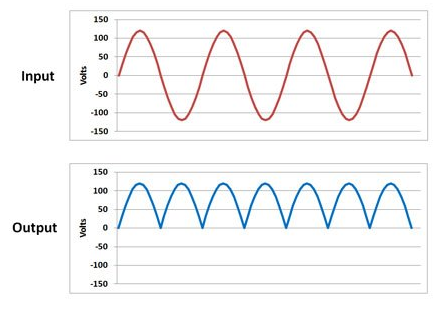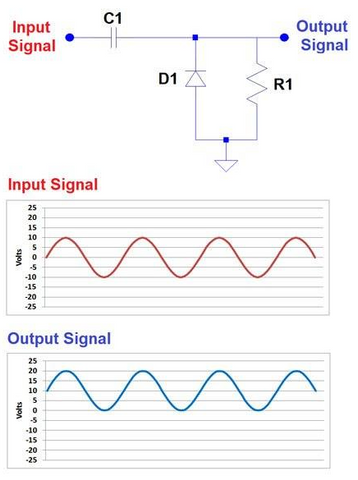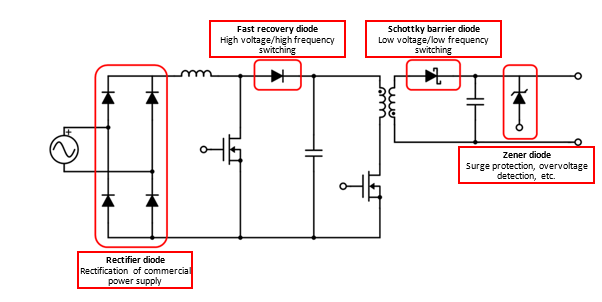Many people have doubts regarding the difference between General diode, Schottky diode, and Zener diode so this blog will clear the difference between these diodes and also what are the applications of these diodes. This blog is the continuous blog of the series of Diodes so if you wish to read about any other diodes or basic's of diode then you may visit our website(click for visiting the website). In this blog you will get to learn about the symbol difference, Construction Difference, Diode’s IV-Characteristics Difference, Reverse Recovery Time, Application for each diode, Summary of using diodes in power supply circuits, General diode, Schottky diode and Zener diode with their popular model numbers.

PN junctions have a positive or P-region with positive ions and a negative or N-region with negative electrons in these basic semiconductors. When a forward voltage is applied to the PN junction, electrons from the N-region fill "holes" in the P-region, causing the current to flow solely in one direction. The diodes reverse voltage is the potential barrier that prevents current to flow in the opposite direction.

The Schottky Diode is a type of semiconductor diode that can be utilized in a variety of wave shaping, switching, and rectification applications as well as digital logic gates
Due to their low power and high switching rates, Schottky diodes are used in a wide range of applications.

A Zener diode allows current to flow not just from anode to cathode, but also in the opposite direction when the Zener voltage is reached. Zener diodes are the most widely used as voltage regulators because of this feature.
Symbol Difference between the Diodes

Diodes are electronic components with their circuit symbols, allowing them to be easily identified on schematics. The cathode terminal of a general diode has a single line, however, the line of the cathode section in a Zener diode is Z shaped, and in a Schottky diode, it is bent into an S shape. As seen in the diagram, the anode terminals of all diodes are arrow-shaped.
Construction Difference
General Diode

When the two types of semiconductors, P-type and N-type, are combined, a new device known as a P-N junction diode is generated. The majority carriers in a P-type semiconductor are holes, whereas the minority carriers are electrons. An N-type semiconductor, on the other hand, contains electrons as the majority carrier and holes as the minority carrier.
Schottky Diode

Schottky Diodes are made up of a metal electrode attached to an N-type semiconductor. Schottky diodes have no depletion layer and are classified as unipolar devices.
Zener Diode

Zener diodes are a modified form of PN silicon diode used extensively for voltage regulation. The P-type and N-type silicon used is doped more heavily than a standard PN diode.
Diode’s IV-Characteristics Difference
General Diode

While conducting, the voltage drop of the PN junction diode is 0.7V. Current flows from P to N junction that is anode to cathode in forward bias region.
The peak reverse breakdown voltage of a General diode is greater than that of a Schottky diode because a general diode has a bigger depletion region as compared to a Schottky diode during reverse bias condition.
Schottky Diode

When conducting, this metal-silicon contact has a low ohmic resistance, allowing more current to flow and resulting in a decreased forward voltage drop of about 0.3-0.5V.
Depending on the metal electrode employed, the forward current of a silicon Schottky diode can be many times greater than that of a standard pn-junction diode due to this lower value. Note since power equals volts times amps (P = V*I), therefore for a given diode current, Id, a smaller forward voltage drop will result in less forward power dissipation in the form of heat across the junction.
However, the reverse leakage current (IR) of a Schottky diode is often substantially higher than that of a PN-junction diode.
Zener Diode

The Zener Diode is used in its “reverse bias” or reverse breakdown mode, i.e. the diode's anode connects to the negative of the supply. From the I-V characteristics curve above, we can see that the Zener diode has a region in its reverse bias characteristics of almost a constant negative voltage regardless of the value of the current flowing through the diode.
This voltage remains almost constant even with large changes in current, providing the current of the Zener diode to remain between the breakdown current IZ(min) and its maximum current rating IZ(max).
Reverse Recovery Time

When a diode is switched off suddenly, the forward current flowing through the diode takes a small amount of time to die down and this time is called Reverse Recovery Time.
The reverse recovery time for a Schottky diode is very small. The reverse recovery time for a Zener diode as well as the general diode is comparatively longer.
APPLICATION
For the application's part, I will be writing about the diodes personal applications, which means first I will start with General diode’s applications then go on.
General diode
General diode in Rectifying a Voltage
When converting AC to DC, General diodes are used.
Half Wave rectifier:

Full Wave Rectifier:

The input signal is converted to all positives, as shown in the picture below.

General Diodes in clamping circuits

Diodes are used in clamping circuits.
Diodes in the clipping circuit

A diode clipper is an electronic circuit that clips or cuts off an input signal using one or more diodes.
Schottky Diode
Schottky diode applied to dual power

Schottky diodes used as AND gate

Schottky diodes are used as a AND gate.
Schottky diodes used as OR gate

Schottky diodes are used as a OR gate.
Discharge protection

Schottky diodes are used in stand-alone ("off-grid") photovoltaic (PV) systems to prevent batteries from discharging through the solar panels at night, called "blocking diodes".
Zener Diode
Zener diode as a voltage regulator

For regulating voltage across small loads, a Zener diode is employed as a voltage regulator.
Zener diode in over-voltage protection

The voltage across the resistor lowers when the input voltage exceeds the Zener breaking voltage, resulting in a short circuit. The Zener diode can be used to avoid this.
Zener diode in clipping circuits

By limiting the portions of either one or both half cycles of an AC waveform, the Zener diode is used to change AC waveform clipping circuits.
Summary of using diodes in power supply circuits
Finally, I will be simplifying how these diodes are used in a power supply with the help of a diagram.

General or Rectifier diode
General diodes are used for the rectification of general commercial power supplies.The forward V is usually less than 1V, and the reverse recovery time is slower than the two diodes. However, switching capability is not necessary because the power supply's main use is rectification at 50Hz and 60Hz.
Schottky Barrier Diode
Often it is used in low-voltage switching power supplies. It's a term for rectifying diodes found on the secondary sides of DC-DC and AC-DC converters.Schottky diodes are known for their low forward voltage (VF) and fast reverse recovery time.
Conversion efficiency is excellent because the VF is less than 1V even with a high current product.
Zener diode
In power supply circuits, it is used for surge protection and overvoltage detection on the secondary side of the ACDC converter.
Even though the current varies, the voltage remains constant, and it is usually used in the opposite direction.
Zener diodes are useful as constant voltage circuits and protective devices, despite the fact that other diodes are mostly used for rectification.
General diode, Schottky diode and Zener diode with their popular model numbers
|
ZENER DIODES (Zener voltage-Zener Diode part number) |
||
|
1N4001 to 7 |
1N58xx |
3.3V - 1N5226 |
|
1N5391 to 99 |
SS1x |
5.1V - 1N5231 |
|
1N5400 to 08 |
SS3x |
6.8V - 1N5235 |
|
1N914/16 |
1N5711 |
9.1V - 1N5239 |
|
BAV20/21 |
1N6263 |
11.0V - 1N5241 |
|
1N4148 |
74LS |
13.0V - 1N5243 |
|
6A4 |
SS14 |
15.0V - 1N5245 |
At last, hopefully, the difference between these diodes would be clear, now if you wish to buy any of these diodes then you may click on their names present down.

